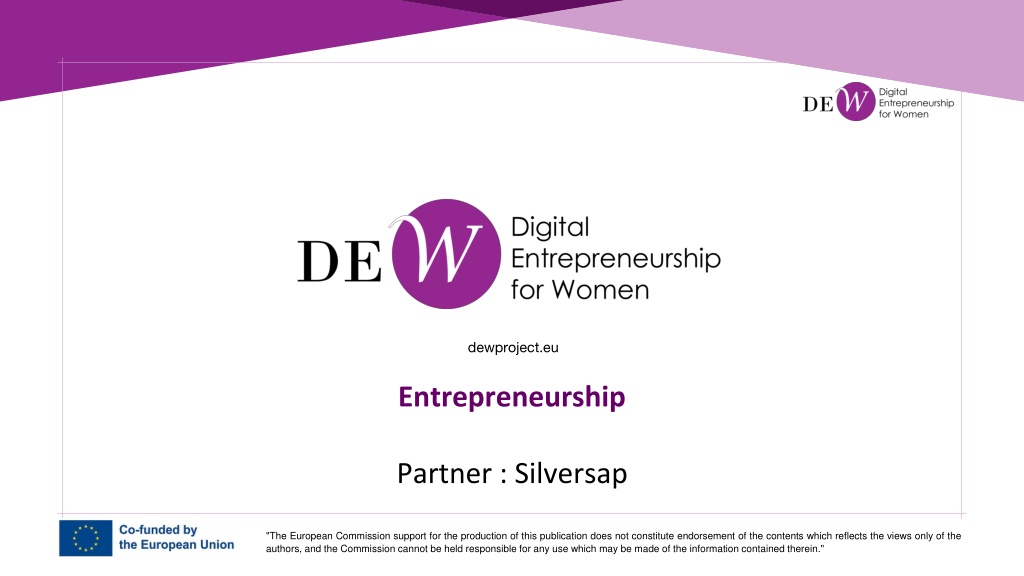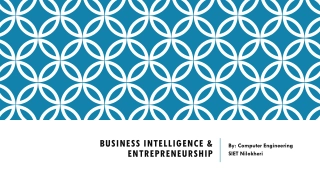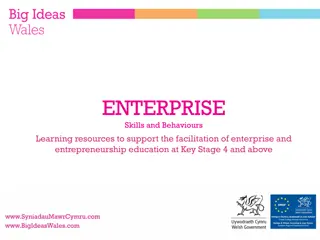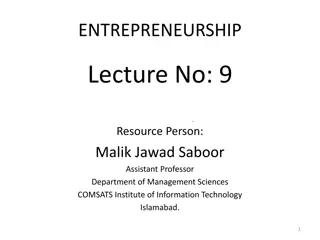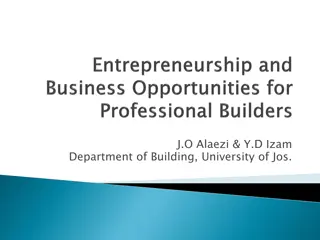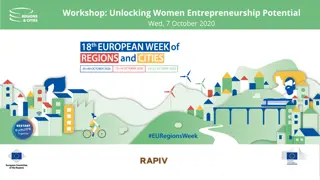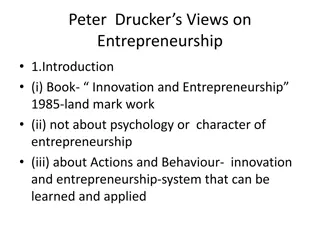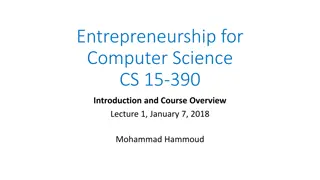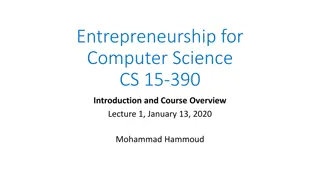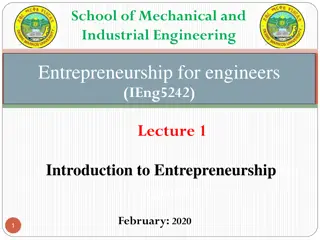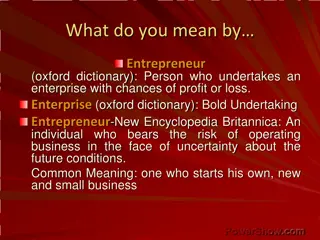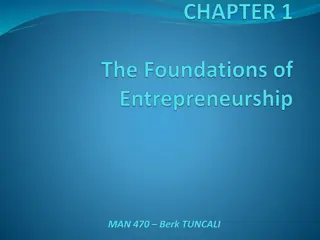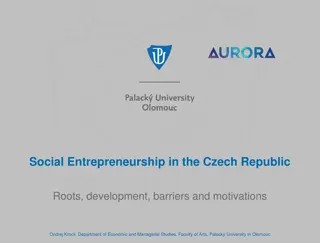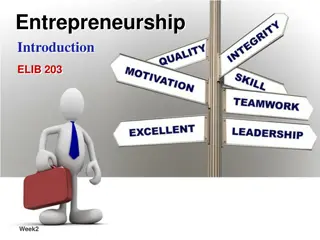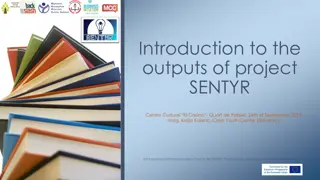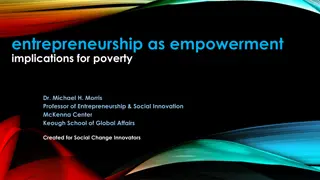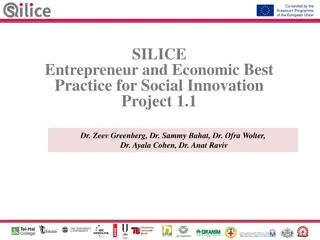Advanced Entrepreneurship Training with DEW Project EU
Explore advanced Entrepreneurship skills with DEW Project EU focusing on motivation, perseverance, creativity, and self-confidence. Gain insights on aligning motivation with achievable goals, boosting creativity to solve problems, and enhancing self-confidence. The training covers theoretical contributions, practical tools, and key concepts essential for entrepreneurs. Dive into modules like Motivation, Self-confidence, Creativity, and more to enhance your entrepreneurial competencies.
Download Presentation

Please find below an Image/Link to download the presentation.
The content on the website is provided AS IS for your information and personal use only. It may not be sold, licensed, or shared on other websites without obtaining consent from the author.If you encounter any issues during the download, it is possible that the publisher has removed the file from their server.
You are allowed to download the files provided on this website for personal or commercial use, subject to the condition that they are used lawfully. All files are the property of their respective owners.
The content on the website is provided AS IS for your information and personal use only. It may not be sold, licensed, or shared on other websites without obtaining consent from the author.
E N D
Presentation Transcript
dewproject.eu Entrepreneurship Partner : Silversap "The European Commission support for the production of this publication does not constitute endorsement of the contents which reflects the views only of the authors, and the Commission cannot be held responsible for any use which may be made of the information contained therein."
Objectives & Goals At the end of this module you will be able to: Advanced level of the EntreComp competence MOTIVATION AND PERSEVERANCE Know what motivates you as an entrepreneur To align your motivation with achievable goals Using divergent and convergent thinking to enhance creativity Advanced level of the EntreComp competence CREATIVITY Stimulate your creativity to solve various problems Know how to boost your self-confidence and know your weaknesses "The European Commission support for the production of this publication does not constitute endorsement of the contents which reflects the views only of the authors, and the Commission cannot be held responsible for any use which may be made of the information contained therein."
Index Unit 1: Motivation Section 1: The outlooks Section 2: Theoretical and scientific contribution on motivation Section 3: Define your needs Unit 3: Self-confidence Unit 2: Creativity Section 1: To understand Section 2: Keys of self-confidence Section 3: Gain more confidence Section 4: Working on yourself Section 1: Stimulate your creativity Section 2: Using divergent and convergent thinking to enhance creativity Section 3: Creative thinking tools to adapt to everyday work "The European Commission support for the production of this publication does not constitute endorsement of the contents which reflects the views only of the authors, and the Commission cannot be held responsible for any use which may be made of the information contained therein."
Unit 1 : Motivation 1.The Outlooks The motivation for entrepreneurship can be based on the following aspects: - Desire for independence; it will be a question of wanting to develop oneself while being creative and free of one's own actions and in search of a quality of life at work, - Being one's own boss; this means ensuring one's own entrepreneurial development and taking responsibility for one's choices, - Desire to undertake at all costs; this is a singular motivation which opens up opportunities, admittedly at risk, but based on its own orientations, - Creating one's own job; it is a desire to take personal responsibility and to choose, - Acquiring capital; this is an objective based on the desire to create and develop added value, - To want to lead; it is a motivating feeling that requires competence and a sense of human and hierarchical relations, - Wanting to develop a business and a team; this is linked to the two previous items, - Carrying out a project; this involves defending it, leading it and adjusting it as necessary in order to carry it through from start to finish, - An opportunity; this may be the case when there is a change in one's life, or to retrain or take over a business..., - To show what I am capable of doing alone. Try to list yours as a woman entrepreneur. What are your motivations ? "The European Commission support for the production of this publication does not constitute endorsement of the contents which reflects the views only of the authors, and the Commission cannot be held responsible for any use which may be made of the information contained therein."
Unit 1 : Motivation 2. Theoretical and scientific contribution on motivation Numerous articles on the subject indicate differences, as the subject is once again very diverse and subjective depending on the person. This means that one cannot practically speak of 'motivation' without more or less explicitly situating oneself in a conceptual or theoretical framework of the subject. Putting forward the notion of 'motivation' engages, in one form or another, causality and pushes to verify a certain 'mechanism'. This does not mean that talking about motivation is necessarily a form of reductionism, but certainly "as many psychological schools, as many motivations! ". The theories are also very diverse and numerous. Scientific articles identify the following: attribution theory ; self-determination theory Self-regulation theory; Self-efficacy theory self-efficacy theory; expectancy theory expectancy theory; theory of planned behaviour. "The European Commission support for the production of this publication does not constitute endorsement of the contents which reflects the views only of the authors, and the Commission cannot be held responsible for any use which may be made of the information contained therein."
Unit 1 : Motivation 3.Define your need As mentioned, motivation refers to the underlying needs that an individual aspires to or is tempted to aspire to. For entrepreneurship, if the need is real and motivating, it must be aligned with achievable goals. The SMART formulation that would motivate the need for entrepreneurship must address these points: Specific, Measurable, Achievable-acceptable, Realistic, Time-bound. The learner must be able to answer these points. Describing his or her motivation to start his or her own business, stating his or her need, he or she should be able to fill in the SMART. Once identified, he/she will be able to measure whether the legitimate motivation is in line with the above 5 points offering him/her much more assurance for an entrepreneurial project. S.M.A.R.T. "The European Commission support for the production of this publication does not constitute endorsement of the contents which reflects the views only of the authors, and the Commission cannot be held responsible for any use which may be made of the information contained therein."
Unit 2 : Creativity Being creative is not just about writing a novel or painting on a blank canvas! Creativity applies to all areas of life, whether it's cooking a delicious meal, coming up with a great idea at work or a new game to share with the family. Creativity exists in all of us, but like anything else, the less we use it, the harder it is to activate or access it easily! Unfortunately, it can also sometimes be undervalued or misunderstood, so we tend to spend less time with it... Some people, such as artists, actors and creators, give priority to their creativity. Driven by this part of themselves, they make it the driving force of their career. Their creativity becomes their mode of expression! This may not sound like a good fit for you, but that doesn't mean you're not creative! Anyone can spend time and energy being creative in their own way. "The European Commission support for the production of this publication does not constitute endorsement of the contents which reflects the views only of the authors, and the Commission cannot be held responsible for any use which may be made of the information contained therein."
Unit 2 : Creativity 1. Stimulate your creativity Creativity is an essential element for the successful development of a company. Just like innovation. Anyone can do it, sometimes you just need to stimulate your creativity. Below we give you 8 foolproof tips to boost your creativity: Dreaming Thinking like a child Knowing how to step back Don't restrict your imagination Look for opportunities to laugh Record your ideas Not sorting ideas in order of importance Think and think big "The European Commission support for the production of this publication does not constitute endorsement of the contents which reflects the views only of the authors, and the Commission cannot be held responsible for any use which may be made of the information contained therein."
Unit 2 : Creativity 2. Using divergent and convergent thinking to enhance creativity Definition : Convergent thinking is a way of finding a well-defined solution to a problem, while divergent thinking will be a way of thinking more creatively to find various solutions. Example : - Convergent thinking: Your computer breaks down, you call a technician directly to fix it. - Divergent thinking: Your computer breaks down, a divergent thinker will try to determine the cause and use different means to solve the problem. They might call a technician or choose one of the following options: watch a tutorial on YouTube, send an email to the service department, etc. This will help him to deduce the best solution. The benefits of divergent thinking : It can sometimes be difficult, as a business owner, to take the time to think divergently. Working too convergently, but also too quickly, can sometimes force you to stay in your comfort zone. Divergent thinking, on the other hand, will allow you to, but not limit yourself to : Identify new opportunities Generate ideas with multiple functions Find creative ways to solve solutions "The European Commission support for the production of this publication does not constitute endorsement of the contents which reflects the views only of the authors, and the Commission cannot be held responsible for any use which may be made of the information contained therein."
Unit 2 : Creativity 2. Using divergent and convergent thinking to enhance creativity How can we adopt more divergent thinking ? 1. Reflect on your thinking: Take time to reflect on your thinking step by step. By adding steps to your thought pattern, divergent thinking will become easier to acquire. For example, you can take half an hour to an hour to relax before writing emails that contain important decisions. 2. Use brainstorming and mind maps: Brainstorming and mind maps are tools to boost divergent thinking, as they allow you to expand your perception and generate new ideas. Mind maps are a form of brainstorming in which you make a diagram of tasks, words, concepts or other elements related to the overall concept, which allows you to visualise your thoughts and generate new ideas without worrying about structure. 1. Free yourself from time constraints: before making an important decision or solving a problem, it is important to free yourself from all time constraints so that you do not feel obliged to limit yourself to convergent thinking. - Examples of techniques to free oneself from time constraints - Asking for the agenda before a meeting so you can prepare properly Use the timeboxing technique (see glossary) Set your own deadlines before officials. This gives you room to manoeuvre if you need to. 1. Be curious and daring: By habit, or by fear of taking risks, we tend to remain confined to convergent thinking. However, a good project manager must know how to switch from convergent to divergent thinking depending on whether the situation requires a quick and structured solution or an open mind. Subjectivity is not always necessary, but you will often need to combine both types of thinking to succeed in your leadership role. "The European Commission support for the production of this publication does not constitute endorsement of the contents which reflects the views only of the authors, and the Commission cannot be held responsible for any use which may be made of the information contained therein."
Unit 2 : Creativity 3. Creative thinking tools to adapt to everyday work Use an idea book. A notebook in which you have to write a word, draw something and put a picture every day. Take the messiness out of the notebook and use it as an outlet. To mindmap on the Miro platform Get inspiration on Pinterest "The European Commission support for the production of this publication does not constitute endorsement of the contents which reflects the views only of the authors, and the Commission cannot be held responsible for any use which may be made of the information contained therein."
Unit 3 : Self-confidence Self-confidence is an essential quality for feeling good about one's life. It is defined as the awareness (or belief) that one has the ability to succeed. Confident people believe that they have good abilities regardless of external events. Confident people are not, however, free from fears or doubts. It is precisely this ability to believe in one's own abilities despite negative emotions that is a sign of self-confidence. Even when things go wrong, they continue to believe in their ability to succeed. In everyday life, this quality can be translated into the ability to overcome fears, to move forward in spite of difficulties, to speak in public, to be charismatic, to not allow oneself to be stressed in difficult situations, to have the will to defend one's opinions regardless of what others think or do, to have the courage to try something new or to take on a project. The good news is that being or not being confident is not inevitable. You are not born that way. The reason is simple: self-confidence is not a reality, but a belief that we build about ourselves over the course of our lives. It is a pure concept, an interpretation, a thought that does not exist in the real world. Self-confidence is therefore a quality that needs to be worked on, that develops over time and that can be considerably improved by appropriate personal work. "The European Commission support for the production of this publication does not constitute endorsement of the contents which reflects the views only of the authors, and the Commission cannot be held responsible for any use which may be made of the information contained therein."
Unit 3 : Self-confidence 1.To understand SELF-ESTEEM VS. SELF- CONFIDENCE What is the difference between self-esteem and self-confidence? Self-confidence and self-esteem are two concepts that are often confused. They are different in nature but are strongly linked. Self-esteem is the continuous evaluation of my value, the importance I give myself as a person. It represents how valuable I consider myself. It is developed by being true to oneself, by respecting one's needs, emotions, limits, values, etc. Self-confidence is acquired once we have sufficient self-esteem. It is the realistic and punctual evaluation that I make of my capacities to face a particular situation. It represents how capable I consider myself to be. It is developed through the accumulation of experience in specific areas. It is quite normal for me to feel insecure when doing something new. Only by practising to develop my abilities will I increase my confidence in this area. "The European Commission support for the production of this publication does not constitute endorsement of the contents which reflects the views only of the authors, and the Commission cannot be held responsible for any use which may be made of the information contained therein."
Unit 3 : Self-confidence 1.To understand Self-confidence can be acquired but many people lack it. These are the 4 main causes of lack of self-confidence and try to analyse them: Fear of criticism The feeling of inferiority An unsupportive environment Obsession with perfection "The European Commission support for the production of this publication does not constitute endorsement of the contents which reflects the views only of the authors, and the Commission cannot be held responsible for any use which may be made of the information contained therein."
Unit 3 : Self-confidence 2. Keys of self-confidence When working on self-confidence and looking at the development of self- confidence, four major keys stand out: The Knowledge of your resources The will The realism questioning "The European Commission support for the production of this publication does not constitute endorsement of the contents which reflects the views only of the authors, and the Commission cannot be held responsible for any use which may be made of the information contained therein."
Unit 3 : Self-confidence 2. Keys of self-confidence The will : Self-confidence cannot be the result of a feeling or sensation. The starting point for absolute confidence is in the mind, through the willpower you are able to display. You often meet people who seem to be tremendously confident in themselves. Contrary to what you might imagine, the driving force behind their behaviour is not certainty but a real will to act. So they are full of uncertainties like any of us, but that is not a problem, only the desire. "The European Commission support for the production of this publication does not constitute endorsement of the contents which reflects the views only of the authors, and the Commission cannot be held responsible for any use which may be made of the information contained therein."
Unit 3 : Self-confidence 2. Keys of self-confidence The realism : Self-confidence should not suffer from blindness but be based on the richness and variety of your personal experiences. Blind confidence is the best way to fail inexorably without even understanding why. Unless you are a megalomaniac, you must use your vital reflexes to protect yourself from overconfidence. It is ultimately a natural attitude to focus on what you have achieved in the past to better anticipate what lies ahead. Whatever the area concerned: professional, family, social, emotional... "The European Commission support for the production of this publication does not constitute endorsement of the contents which reflects the views only of the authors, and the Commission cannot be held responsible for any use which may be made of the information contained therein."
Unit 3 : Self-confidence 2. Keys of self-confidence Knowledges of you resources : Being confident does not mean that when faced with a new situation you will be in control. By being realistic, you are in a good position to assess your own resources, which will help you to cope with the problem presented. You can never know in advance whether you will actually achieve your goals In others, self-confidence often seems to be all-encompassing. In reality, however, it is always specific. It depends on the experiences in each area and for each person. "The European Commission support for the production of this publication does not constitute endorsement of the contents which reflects the views only of the authors, and the Commission cannot be held responsible for any use which may be made of the information contained therein."
Unit 3 : Self-confidence 2. Keys of self-confidence The questioning : In terms of self-confidence, keep in mind that nothing can be taken for granted. For example, if you stop playing tennis or piano for several years, your level of skill and self-confidence will decline. You will always have the hope of regaining your forgotten skills. What you were technically able to do once, you can probably do again today. At least if your physical abilities have not diminished. As you get older, you have to accept the decrease in performance willingly. But beware of negative experiences: they can destroy your self-confidence if you don't manage to question yourself, to really question yourself. An essential first step in developing self-confidence is to determine what precisely this notion means to you. Saying "I want to be more self-confident" is like saying "I want to travel.... Yes, but when, where and how? In concrete terms, it could be: "In the presence of people I don't know, I want to be able to participate in the conversation in a relaxed way and also be able to ask and answer questions. "The European Commission support for the production of this publication does not constitute endorsement of the contents which reflects the views only of the authors, and the Commission cannot be held responsible for any use which may be made of the information contained therein."
Unit 3 : Self-confidence 3. Gain more confidence Spoiler : No you won't gain confidence without effort Self-confidence is something you have to work on, think about, but most importantly, it doesn't happen by itself. And here are some ways in which you can work on your self-confidence: Getting to know yourself Asserting your personality Learning to say no Overcome you complexes "The European Commission support for the production of this publication does not constitute endorsement of the contents which reflects the views only of the authors, and the Commission cannot be held responsible for any use which may be made of the information contained therein."
Unit 3 : Self-confidence 4. Working on yourself You have understood what self-confidence is all about, are you ready for action? That's great! We give you some tools that will allow you to move forward more effectively in your quest for self-confidence. The diary The inner speech Talent assessment Building one's own scale of values "The European Commission support for the production of this publication does not constitute endorsement of the contents which reflects the views only of the authors, and the Commission cannot be held responsible for any use which may be made of the information contained therein."
Summing up Self-confidence Creativity To understand Keys Gain more confidence Working on yourself Outlooks Contribution on motivation Define your needs Motivation To stimulate Divergent and convergent thinking Tools "The European Commission support for the production of this publication does not constitute endorsement of the contents which reflects the views only of the authors, and the Commission cannot be held responsible for any use which may be made of the information contained therein."
Thank you! dewproject.eu "The European Commission support for the production of this publication does not constitute endorsement of the contents which reflects the views only of the authors, and the Commission cannot be held responsible for any use which may be made of the information contained therein."
